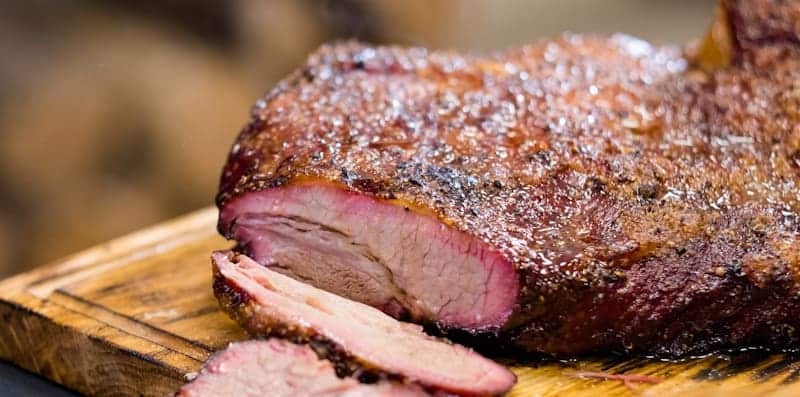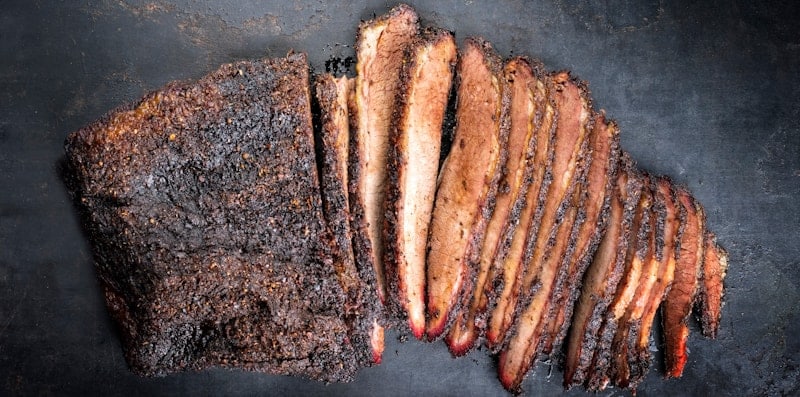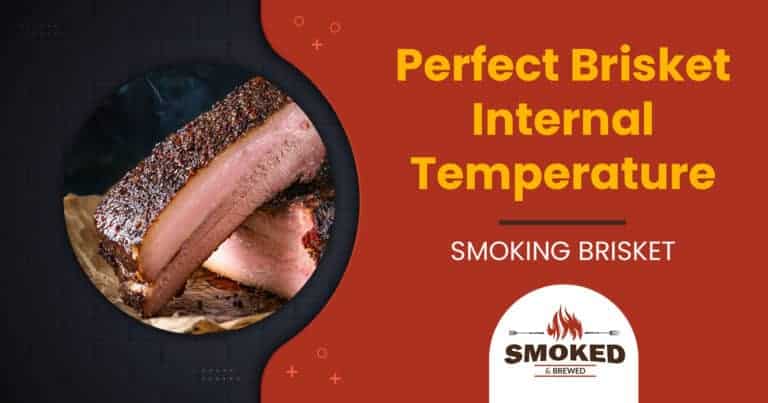Brisket is one of the most intricate cuts of meat to prepare skillfully. Here’s how to get a decent smoked brisket with the perfect brisket internal temperature.
The ideal way to smoke brisket is to smoke it low and slow, allowing the meat to break down effectively. You can then pull the brisket from the smoker when a probe slides in smoothly or the internal temperature sits between 180 to 200 F. Most pro pitmasters agree that 204 degrees is the perfect brisket internal temperature.
Smoked brisket needs to be moist and soft in the middle while smoky and crunchy on the outside. Many criteria affect the smokiness of the brisket, but maintaining the proper internal temperature is critical. We’ll discuss the ideal brisket interior temp, how you achieve it, and how you can quantify it.

What Is The Right Internal Temp For Good Brisket?
Ideally, the internal temperature of the brisket should be between 195 and 204 F in the centermost section of the meat. However, it would be best to let your brisket rest until the internal temperature reaches 170 F for ideal results.
How To Test If The Brisket Is Done
Probe testing to monitor the internal temperature of the meat is the primary method of checking whether the brisket cook is complete. When the internal temp reaches 190 F, you can slide in a thermometer probe. It should go in and out with barely any resistance when the brisket reaches proper cooking temperatures..
Another way to check is by picking the brisket up and jiggling it. If it jiggles like jelly, it’s probably done.
How To Get The Perfect Brisket Internal Temperature
If your brisket’s internal temp comes to 145 F but starts to rise slower, you might have hit “the stall”. That can take hours to rise from 145 F to a proper temperature of 165 F. At this level, the meat starts sweating. The muscles then contract in the brisket to push moisture out.
That water proceeds towards the surface of the brisket. It evaporates and reduces the brisket’s temperature and the smoker’s overall heat. In such a situation, you need to do the following:
1. Wrap The Brisket
The stall occurs when the moisture from the beef evaporates into the atmosphere and reduces the grill’s temperature. You can prevent this entirely by wrapping your meat. This method is public with pro pitmasters and is called the Texas crutch.
Wrap the brisket in unwaxed butcher paper or regular aluminum foil. Make sure that there aren’t any open crevices or holes. Before that, baste your brisket with some water, cider, beer, or juice. That can prevent any further loss of moisture.
2. Turn Up The Temp
To offset the consequences of evaporation, turn up the smoker temperature to 300 F. Once the brisket reaches 165 F, you can bring the temp back down.
How Long Should You Smoke Brisket Per Pound?
The number of hours for every pound is a decent way to estimate the time to smoke a brisket, even though it’s not a hard or fast rule. The smoking time per pound relies on a few conditions but primarily focuses on the smoking temp and method. It can range between 30 minutes and two hours for every pound.
For a rough clue of the number of hours you need to prepare your brisket, you should follow these guidelines:
- A brisket needs 90 to 120 minutes at 225 F for every pound.
- It requires 60 to 90 minutes at 250 F for every pound.
- It needs 30 to 45 minutes at 300 F for every pound.
Best Temp to Smoke Brisket
Most BBQ pros suggest smoking a brisket within a range of 225 F and 250 F. While it might take a long time to cook at 225 F, the outcome is a moist brisket that everyone loves. Once you figure out the basics of smoking briskets, it’s possible to cook them at higher temperatures.
How Long Does It Take To Smoke A Brisket At 225 F?
The time per pound to smoke meat relies on a smoker’s temp and the brisket’s size and weight. So, for smoking a brisket at 225 F, 1.5 to two hours is ideal for every pound of meat to get moist and tender briskets.
So, a twelve-pound brisket takes around 18 hours to smoke at 225 F. That should give you a reasonable estimate, but always keep some extra time if the cooking takes longer. Also, always remember to save time for the brisket to rest when done. It’s also essential to maintain a keen eye on the thermal probe since the rate varies according to the meat and the smoker.
How to Get the Perfect Brisket Internal Temperature Faster
If you don’t have much time to wait for a brisket to finish cooking, there are certain things you can do to fasten the process. The most compelling way to move the process along is to boost the temp. At 300 F, meats can cook much faster, but you do risk the chance of getting a drier and less flavorful brisket.
You can also use the Texas crutch method mentioned earlier to get the correct internal temperature faster. That means you take the brisket off the smoker when the interior temp stalls at about 150 F, wrap it up in butcher paper or foil, and then put it back on the smoker for a longer time.
Aluminum foil quickens the smoking process greater than butcher paper. That said, butcher paper is ideal for preserving the crunchy exterior of the brisket since it’s more porous than foil. Regardless, using this method shortens the cooking time to around 45 minutes for every pound without negotiating the smokiness and crispiness of the meat.
Shifting the brisket to an oven to finish the cook is another way of speeding things up. Certain pitmasters suggest against that, but it shouldn’t have too much effect on the taste. Finally, you can entirely avoid the low and slow methods and use different methods. But the hot and fast process has its trials, so it’s essential to learn the correct way to use it.
Ensure to preheat the smoker to 350 F and put the meat fat side down to avoid burning the base. Then, wrap the brisket once it gets to an internal temp of 170 F. Finally, you put it back on the grill, this time fat side up. Continue smoking till the internal temperature gets to 204 F.
Even at the perfect brisket internal temperature, the brisket might not reach the ideal tenderness. So, check the brisket using a probe before taking it off the grill because it may need more time. While the results aren’t usually as delicious as the low and slow process, the hot and fast method is ideal for eating brisket in a shorter amount of time.

Why You Should Smoke Low And Slow
A brisket is a challenging piece of meat that comes from the lower torso of the animal. Such a muscle needs a long and slow cooking method to give the muscles and tissue time to break down. The extra time also helps the fat render better, providing a more decadent, juicier cut of meat.
While smoking brisket, it’s essential to reach that sweet spot in temp. We already know the consequences of the hot and fast method of cooking. But if you go too low, then the meat stays for too long, between 40 F to 140 F. That is a dangerous temp range for bacteria to grow.
Also read: What’s the Best Griddle Temp for Burgers?
Final Words
Getting the perfect brisket internal temperature of 204 F can give you a delicious piece of meat. As long as your smoker’s temperature stays constant and you allow the right time for the resting period, you’ll have a delicious brisket. So, happy smoking!
Keep reading:
- How to Make a Smoker At Home [BEGINNER TO ADVANCED]
- How Many Pounds Of Brisket Per Person? [ANSWERED]
Scot has loved smoking food in his free time for the last few years. Each major holiday or off-weekend, Scot spends days testing and prepping new recipes for perfection.

